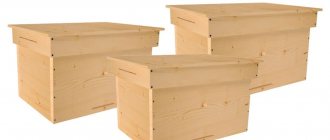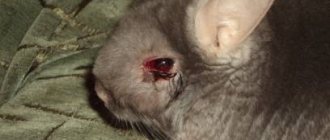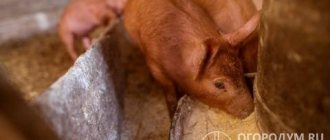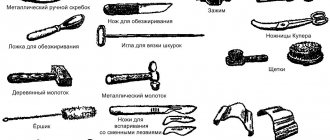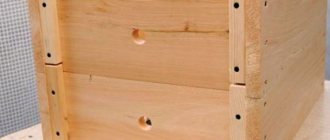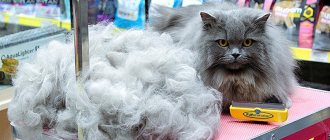In order for a chinchilla to live in comfortable conditions, it must first be provided with a good, comfortable and spacious cage. The best option would be a display case for a chinchilla. It can be purchased at a pet store or, if desired, you can make it yourself.
Important. For health and good spirits, these animals need space.
What is a showcase for?
A display case for chinchillas is needed for their comfortable and cheerful life. Animals feel uncomfortable in cramped cages. For security and maximum comfort, the display case for chinchillas should be closed. In its manufacture, various materials can be used (chipboard, natural wood, plexiglass).
Of course, natural wood is considered the best material. It is safe, does not release toxins and is durable. But at the same time, wood absorbs odors and deteriorates due to high humidity. Products made from chipboard and aluminum profiles are considered a good choice. They are more practical, durable and resistant to negative factors.
Important: veterinarians recommend keeping mobile chinchillas in tall structures with numerous shelves and stairs. It is also necessary to place wooden objects in their housing so that the animals sharpen their teeth on them.
Does your chinchilla like to sharpen his teeth?
Materials and tools
When choosing wood, a natural material that is safe for the health of animals and their owners, the problem of teeth grinding is also solved. Making your shelving unit from solid wood will provide the most durable and long-lasting results. But such material is quite expensive in itself, and also requires processing in several stages - grinding, impregnation with special protective compounds, and varnishing. A cheaper analogue would be laminated chipboard - this material does not require special processing, is easy to care for, and products made from it look good in the interior of an apartment.
To protect the chipboard from the teeth of animals, removable shelves are made of wood; these boards can be easily replaced when they become unusable.
Also, due to the ability of wood to absorb odors and moisture, display cases are sometimes preferred to be made of aluminum profiles and plastic. For the façade of the rack, it is better to take tempered glass 6 mm thick, and a galvanized metal mesh is used for ventilation.
To cover the cut areas, a thin PVC tape of suitable width is suitable. The bottom of the display case is covered with a tray to facilitate cleaning. From the tools you will need to collect the following set of items:
- hacksaw;
- stationery knife;
- drill and drill bits;
- metal scissors;
- self-tapping screws, tie screws;
- electric jigsaw;
- level, roulette.
Tools can be purchased at any hardware store. It is better to buy glass doors with hinges and a lock already installed, otherwise you will need to find tools for working with glass. To make a metal display case, you will also need special drills, pliers and a grinder.
Advantages of a display case for chinchillas
The main advantages of display cases for chinchillas include:
- saving free space. These structures are often placed along the wall, opening up a large space for outdoor games, but take up less space than cages;
- aesthetics. Such structures have a neat appearance and fit harmoniously into the surrounding environment;
- opportunity to watch animals. In such buildings, the facades are made of transparent glass, so it is convenient to observe them;
- low noise level. Unlike cages, display cases are more closed and do not have metal bars that animals love to chew;
- large internal space that allows you to place numerous shelves, racks, ladders and other toys for rodents;
- lack of garbage and efficiency of cleaning. Unlike an open cage, food, hay and other debris that animals often scatter around will not be scattered near the display case.
Showcases must be of a certain size
Materials and tools
Before you make a display window for your home, you need to decide on the material from which it will be made. To solve the problem of teeth grinding, it is better to choose a natural material. The tree is safe for the health of the animal.
However, the overall cost will be significant. You can use LDPB - good quality and inexpensive. Ideal for the construction of such a structure.
The disadvantage of wood is its ability to absorb all odors and moisture. To avoid this, the window is made of profile or plexiglass. PVC tape is used to glue the cut areas together.
Commonly used tools include a tin saw, utility knife, drill, self-tapping screws and bolts, and a measuring tape. They can be purchased at any hardware store. Metal mesh is purchased for making side walls.
From scratch
The first thing to do is decide where to place the finished cabinet. To do this, a contour is drawn up with the parameters of the future structure. You can see what it looks like on the Internet. Then you need to buy the necessary materials at the nearest hardware store.
Laminated chipboard is considered an inexpensive material for constructing housing for rodents. A mesh made of organic glass or metal is also used. A complete drawing with exact values of individual components must be completed before construction begins. Minimum dimensions - 80x80x50 cm.
Step-by-step instructions for making display cases with your own hands:
- The side panels and ceiling are cut from chipboard. A window is cut out on each side panel. Instead, a metal mesh will be used. The cut pieces of mesh are attached to the walls with self-tapping screws.
- Attach the back and sides to the wood pallet using screw ties. To do this, make small holes using a drill. The walls are attached to each other, and the ceiling is attached to the ceiling.
- You can make a special place to store food or toys. It is built in the form of a bollard attached to the bottom of the structure.
- A glass door with metal hinges is attached to the front wall. Glass must be treated to prevent rodent injury. Shelves are installed inside.
- If using a trash can instead of a trash can, build a pull-out trash bin.
Made from plexiglass
Sometimes organic glass is used in doors. This material is not durable. It gets scratched quickly and loses its beauty due to its cloudy appearance. Low strength makes it possible for the animal to bite through the hole.
Firstly, the frame is built from wooden beams. Plywood is used as the back wall. Attach the side walls of the metal mesh to it using self-tapping screws. After fixing the lid, the glass door is suspended. Finally, you need to set up an apartment for your pet.
From an old closet
The easiest way is to make a display case for chinchillas with your own hands from an unnecessary display case. To do this, follow the instructions exactly:
- Measure the cabinet to prepare a detailed drawing. It shows the exact values as well as the position of additional elements.
- The side walls have been removed and metal mesh is used instead. The edges must be trimmed.
- Cut small plates from plywood. These are future shelves in the animal's house. Using self-tapping screws, attach them to the structure. The door was replaced with glass. It is advisable to put a lock.
- The last step is to add personal items and accessories.
Do not place the cabinet near heaters, windows or balconies.
Source
Requirements for the showcase
There are specific requirements for arranging housing for animals. The dimensions of the display case must be no less than:
- length – 80 cm;
- height – 50 cm;
- width – 80 cm.
This area can comfortably accommodate one animal. If you plan to keep two rodents, the area will need to be almost doubled.
Since chinchillas are rodents, and they tend to taste everything, their housing must be made of environmentally friendly and safe materials. An excellent option would be to use natural wood. Also, when maintaining them, it is worth taking into account temperature and humidity. To ensure that the home is well illuminated, special lamps are used.
Attention : before placing the animal in a new home, you must carefully inspect it for sharp corners, otherwise the pet may be injured.
Before moving the animal into the house, it must be equipped with toys, a drinking bowl, feeders, a hay barn, play equipment and a sleeping area.
Original ideas
Creative owners of furry pets offer interesting options for making multifunctional houses. So, one of them is a house combined with a hay barn: shelter - one, material for gnawing - two, a place for hay placed between the sticks - three. To make such a product you need a minimum of materials:
- board as a roof,
- dry birch or hazel sticks (due to the density of this type of wood, the chinchilla will chew them longer),
- a block for fastening them,
- small screws, screws or nails - for the same purpose.
When finished, the house looks like a nice and quite cozy hut for a rodent.
You can make a special “gnawing” house for your pet from branches and wooden scraps, fastening them with the same connecting parts.
Below are the drawings of the houses - several options.
Homemade houses are also an economical option. If you build an entire cage or display case for a chinchilla with your own hands, its total price will be several times lower than the store price. So, dear craftsmen, get a jigsaw in your hands!
How to make a display case for a chinchilla with your own hands at home
Despite the large assortment of display cases on the Internet or in pet stores, it is quite easy and simple to do it yourself. This way you can build an interesting structure at minimal cost.
What materials can you use to make a display case for a chinchilla with your own hands?
You can make a display case for chinchillas with your own hands from different materials:
- natural wood. This is the safest and most reliable option. The advantages of wood include environmental friendliness, aesthetics and resistance to negative factors. And it is worth adding to the disadvantages: absorption of unpleasant odors, expensive production costs, difficulty in operation;
- Chipboard. The simplest and most inexpensive option. Laminated chipboard is sold in stores in a wide range of colors, textures and textures. The material is easy to work with and can be used to build a structure of any complexity. The disadvantages include the fact that laminated chipboard contains harmful substances. If the animal chews on the material, it may become poisoned;
- plexiglass. This option will prevent the absorption of foreign odors, will be easy to clean, and will have a transparent and beautiful appearance. Such designs will harmoniously fit into modern styles and will serve as their main decoration. As for the disadvantages, it is difficult to clean. The glass will have to be constantly rubbed with window cleaners to get rid of stains. In addition, this material quickly scratches and cloudy spots appear on it;
- old closet. The most lightweight option. Old furniture can be easily and quickly converted into a fairly comfortable and convenient house for rodents. In this case, you will spend a minimum of free time, materials and finances. As a rule, the entire process of making housing for rodents from an old cabinet consists of making special holes for ventilation and dividing the housing into separate floors.
The house must be installed on a slight elevation
Materials and tools
In the process of making a display case for chinchillas, you will need the following materials and tools:
- saw - hacksaw;
- stationery knife;
- drill with drills;
- metal scissors;
- screws and fasteners;
- jigsaw;
- level and tape measure;
- lumber (natural wood, chipboard);
- glass for making doors;
- net;
- boards for making shelves, stairs and other accessories;
- hinges for fastening doors;
- a lock on the door;
- PVC edge (if chipboard is chosen as the main material);
- screwdriver
Step-by-step manufacturing instructions
Attention : before you start cutting lumber, you need to make a competent drawing of the future product with all dimensions.
The process of making a display case from lumber is as follows:
- Using a marker and a ruler, markings are applied to the lumber according to the drawing and the future product is detailed using a jigsaw.
- Holes for ventilation are made in the side walls and sealed with galvanized mesh, which can be easily cut with metal scissors. The mesh is secured with self-tapping screws with wide heads.
- The top of the product can be made entirely of mesh. Thus, there will be a favorable microclimate inside the display case, and it will be convenient to hang various toys and hammocks for animals on the mesh.
- Next, holes are drilled in all places for fastening the parts together.
- Assembly begins with attaching the side and rear walls to the pallet, and the top is installed on top of the structure.
- Next, the interior space is equipped with shelves and stairs.
- Then the hinges are installed to hold the glass facades.
- All laminated chipboard cut areas are glued with PVC edges using a hair dryer or iron.
Attention : to prevent animals from passing through, their housing is raised 30 cm above floor level. To do this, the display case can be equipped with legs, or even better, at the bottom you can build a bedside table for various pet supplies (food, bathing suits, hay).
Where does the rodent live?
Through experimentation, experts came to the conclusion that the optimal habitat for this rodent would be a special display cage. Such display cases can be found in specialized stores, but if a person who wants to have a chinchilla in the house has certain blacksmithing and carpentry skills, he can save a lot of money by making this place for the future pet to live with his own hands. Let's try to figure out what a showcase is and how it differs from a regular cell?
Imagine your grandmother's sideboard, or rather its upper part. This is a cabinet with doors at the bottom and glass shelves at the top, always behind glass doors that can be made sliding or opening. This top is a showcase. For a chinchilla, the shelves can be made from plywood, and the glass doors can be replaced with fiberglass or something similar, as long as light gets through.
It must be said that a chinchilla will be much more comfortable in a display case than in a cage, and there are many reasons for this.
- The showcase is more spacious than the cage.
- The cage is made of twigs, there is nowhere to hide, and the chinchilla needs a closed den. Showcases are optimally adapted for this purpose - the owner can improvise quite freely with closed areas.
- There is more space in a display case than in a cage, because it can be made to any depth.
- Various natural materials from which the owner can build a display case will suit the rodent more than metal rods. Chinchillas prefer secluded places where they can hide if necessary, and if they are wooden, this is normal.
- A rodent located behind the glass of a display case creates less noise and bothers the owners less.
- It is not difficult to remove it from the display case if there are several doors in the front wall.
- If debris is constantly flying out of the cage through the bars, a solid wall will avoid this unpleasant feature, and will also provide access to each “floor” of the display case; cleaning will not take much time.
- The display case can be “camouflaged” if it is made of materials that match the color of the furniture.
- If you equip the display case with wheels, it can be moved from room to room to create an acceptable temperature regime for the rodent and not overheat it. It should not be forgotten that temperatures above 25 degrees Celsius can cause heatstroke in chinchillas, as these animals originate from the high Andes mountains of the South American continent.
Having come to the conclusion that a showcase will be the most convenient habitat for a chinchilla, it is worth paying attention to the fact that you can make a showcase with your own hands from wood, aluminum profiles and plastic structures. There are a number of requirements for the manufacture of display cases:
- the smallest space for a chinchilla should be at least 800x800x500 mm;
- when keeping more individuals, the size increases and multiplies;
- the materials from which the display case is made must be sufficiently durable and safe, since rodents tend to try them “on their teeth”;
- the display case should be dry, warm, well (but not excessively) lit and have good ventilation;
- During the production process, it is necessary to remove sharp edges and protruding corners of the panels, which can lead to accidental injury to the animal.
We offer you the opportunity to get acquainted with a wooden craft with your own hands. This is one of the most important requirements for display cases of this type, so that the animal does not feel cramped. Chinchillas require at least 0.4 m2 per person. In addition, this area does not depend on either the length or the width of the display case: both can be changed at will or in accordance with the size of the apartment.
Why is it often recommended to use old cabinet frames as a base? The point is practicality and ease of remodeling: you will have to put in a minimum of effort to turn it into a showcase. Although a certain danger to the animal may lie precisely in the material from which the wardrobe is made.
Here are step-by-step instructions for assembling a cabinet display cabinet.
- We remove the doors.
- If there are shelves, cut holes in them. Chinchillas will need this to transition between tiers.
- If there are no shelves, there is room for imagination - the shelves can be placed in any order.
- The material for the shelves must be natural wood, since chinchillas prefer to “try” horizontal surfaces: gnawing on a vertical wall is less comfortable.
- It will be necessary to make ventilation holes in the upper part of the mobile case so that air masses can circulate freely inside the display case.
- Don't forget to cover these holes with wire mesh - this chinchilla won't even try to chew.
- The removed doors are replaced with a metal mesh stretched over the frame, or made of transparent material. Most experts recommend networking.
- To carry out work on the manufacture of such a frame, it is recommended to take the same removed “original” doors and replace the panels with a mesh, leaving an outer door frame about 100 mm wide for attaching the mesh.
- It’s very good if the cabinet design initially included lower drawers. This will make the conversion even less energy-intensive: only in the next step will you have to remove the floor of the main part of the cabinet and replace it with a fine mesh, under which it is easy to place a container where excrement and debris will fall. This will make the cleaning process much easier.
How to set up a display case for a chinchilla
In order for your pet to feel as comfortable as possible in its new home, it needs to be equipped with various toys and accessories. For rodents, it is mandatory to place:
- a special house where he can hide from prying eyes and relax. Its size should be slightly larger than the size of the animal itself;
- shelves where the pet will rest while observing its surroundings;
- hammock. It can be single or multi-tiered;
- various wooden toys, foam balls;
- wheel and tunnels for running;
- a bathing suit with sand (it is placed in a cage every day for 20 - 30 minutes);
- mineral and salt stones;
- drinking bowl, feeder and hay.
Farm cage
A chinchilla cage on a fur farm is almost no different from a rabbit cage. The only differences are an additional shelf above the floor of the cage and a passage for the male, who mates with 4–8 females at once on the farm. You can also make a cage for a fur chinchilla with your own hands.
For this you will need:
- galvanized mesh;
- scissors for cutting metal;
- clamps;
- pliers.
Manufacturing process:
- The mesh is marked and cut into pieces.
- An additional shelf is tightly attached to one of the side parts.
- Then all sides are secured with clamps.
- A door is cut out in the front part of the cage and hung on the fasteners.
- A passage is made in the side walls for the male chinchilla and covered with a small tunnel. The tunnel is needed so that the male can rest.
- They place a feeder, a water bowl, a nursery and a house in the cage and let the chinchillas in.
On a note! You can take a rabbit house.
If necessary, houses are made independently according to the same scheme as for rabbits.
Main varieties
When looking for a home for your pet, you can find different variations of cages. They differ in appearance, price and quality.
Let's look at the most common options.
From metal rods
This is the most common and very budget option. At the bottom of such a cage there is usually a tray with sawdust, which is easy to clean. It is easy to attach the necessary accessories for your pet to the mesh. But this design does not dampen noise at all; any movement in it will make sound.
Display cage
The material usually used is wood, although other models are also available. Such a cage is a real work of art and the pet becomes part of this composition. It will easily fit into the interior and complement it.
From old furniture
Masters can give a second life to any item. Unnecessary furniture in their hands turns into a beautiful display cage.
For breeding chinchillas
This design is a metal cage divided into several sections, each of which houses a pet.
What structures cannot be used
Sometimes chinchilla owners, trying to save on the purchase of a specialized cage, keep their pets in structures that are completely unsuitable for this. Under no circumstances should you use the following as a home for chinchillas:
- Small cages - furry cats need space to move freely.
- Plastic containers and glass jars. Firstly, such structures are too cramped. Secondly, jars and containers do not allow air to pass through well, which is dangerous for the health and even the life of chinchillas.
- Carrying. Such structures are intended only for short-term transportation of animals.
Some chinchilla owners manage to place fluffies even in large cardboard boxes. But a pet will literally chew such a flimsy house within a day.

